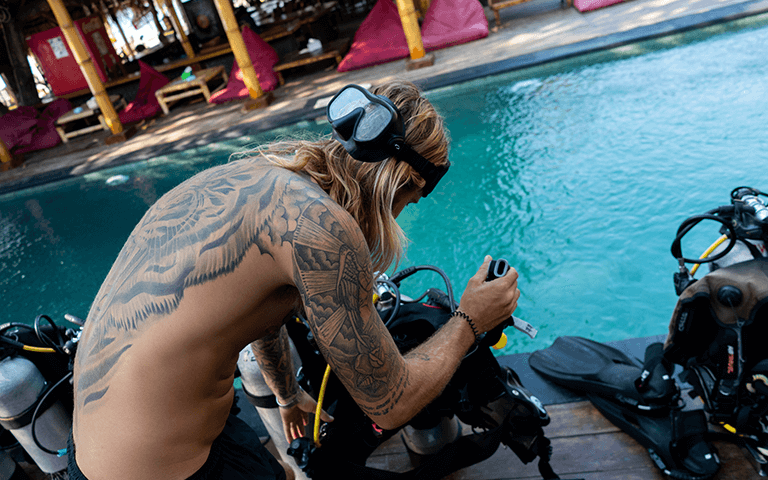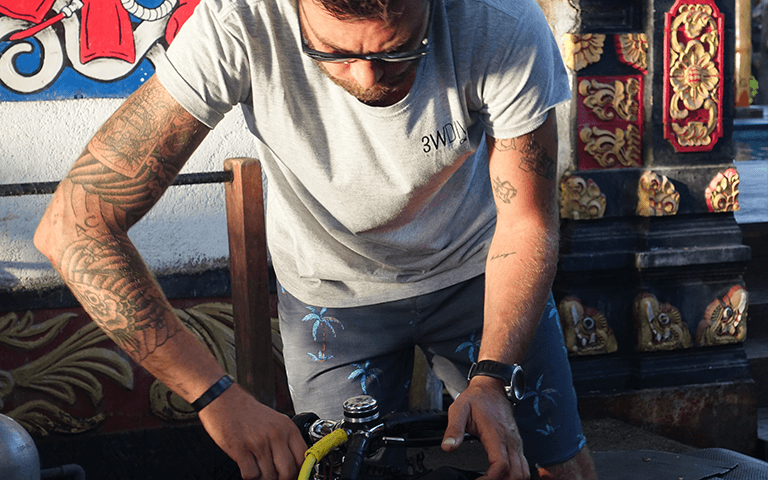by Megan Whitehead
You’ll have tons of experiences and opportunities when traveling. Trying new food, riding a motorbike for the first time, getting a new tattoo, and (our personal favorite, of course) scuba diving! However, for safety reasons, you may be wondering if you can experience all of these things at the same time. For example, new tattoos and scuba diving. Can you mix the two safely?
Many of our instructors have experience diving with new ink. Speaking from our personal experience, we’re going to do our best to advise you on how to dive with tattoos!
Many of our instructors have experience diving with new ink. Speaking from our personal experience, we’re going to do our best to advise you on how to dive with tattoos!
What kind of tattoos can you get in Indonesia?
MACHINE TATTOOS:
You will find a vibrant tattoo community in Indonesia, with world-class artists from all over the globe. The normal method of this art is done using tattoo machines. Shorter time, more detail, but this comes with a longer time to heal. Machine tattoos are done with an automated tool that injects the ink into the skin very quickly while the artist guides the tool and draws the tattoo.
Because it is done with a machine and not by hand, the impact of the needle is much stronger. Therefore it does more initial harm to the skin, and this is why it takes longer to heal.
TRADITIONAL BAMBOO TATTOOS:
When traveling to Southeast Asia, you will most likely hear about the older, and more traditional, bamboo tattoos. These are done by attaching a needle to a bamboo stick, and the artist’s hand pokes the tattoo. This style of tattoo dates back 3,000 years to the Khmer period. How do you think people got body art before mechanical tattoo tools? Soldiers would get bamboo tattoos for strength and protection, while monks would get religious texts on their bodies for spiritual reasons.
The intriguing history and experiences that accompany bamboo tattoos make them quite popular here. Not to mention an epic story behind it! This style is a bit more time consuming, but the healing process is much faster. The tattoo artist is able to control how deep the needle goes, as well as the amount of strength behind it, so it does not cause as much damage to the skin.
When traveling to Southeast Asia, you will most likely hear about the older, and more traditional, bamboo tattoos. These are done by attaching a needle to a bamboo stick, and the artist’s hand pokes the tattoo. This style of tattoo dates back 3,000 years to the Khmer period. How do you think people got body art before mechanical tattoo tools? Soldiers would get bamboo tattoos for strength and protection, while monks would get religious texts on their bodies for spiritual reasons.
The intriguing history and experiences that accompany bamboo tattoos make them quite popular here. Not to mention an epic story behind it! This style is a bit more time consuming, but the healing process is much faster. The tattoo artist is able to control how deep the needle goes, as well as the amount of strength behind it, so it does not cause as much damage to the skin.


Is it safe to get tattoos here?
You may think that Southeast Asia doesn’t have the highest health standards. This simply is not true! Bamboo tattoos carry the same risks as machine tattoos. You will still need a clean space, clean razor, and of course a new needle for every tattoo. Whether you’re getting a tattoo in a shop or a bamboo one somewhere else, keep your standards high and be sure that the environment is clean. Ask to see the sterilizing process, and make sure nothing is reused between clients unless it’s been professionally sterilized first.
Caring for your ink while on an island
The hardest thing about getting a tattoo while on holiday is keeping it clean. Taking care of your tattoo is going to be key to maintaining its crisp and fresh look. This requires keeping the sand and dirt out of it, keeping it clean and moisturized, plus giving it enough time for the skin to close up and heal. With machine tattoos, a lot of the healing time will be dependent on a few factors: how heavy-handed the artist is, the size of the tattoo, if it’s colorful or black and white, as well as how you care for it.
The only way that bamboo tattoos are different is that they tend to scab less and heal faster because they are more gentle (normally). Just like a machine tattoo, you still need to do all of the same things to care for your new bamboo tattoo.
The deal with diving and tattoos
If you’ve never experienced diving before (it’s pretty damn awesome – the Tribe here at 3W highly recommends it!), you have a few options. You can try out diving without committing to the entire Open Water course by doing a short Try Scuba Diving course with an instructor. When going on a try dive, you will spend approximately an hour in the pool before going into the ocean. This time is used to go over skills, teach you how to equalize, and help you get comfortable with the equipment. After this, you get to backroll into the ocean! You will get to dive for 60 minutes, or until you reach the air consumption limit for the dive – whichever comes first.
If you’re a certified diver already, you know the drill for diving!
What does this mean? It means you’re not just exposing your tattoo to a little bit of water. Diving isn’t like taking a 10 minute shower. You’re submerging your tattoo in the pool and/or the ocean for an extended period of time.
This is the problem when you mix tattoos and diving. You will be exposing your tattoo for at least an hour underwater. This saturates the tattoo when you should really be keeping it dry. This is why machine tattoos and diving don’t really mix.
If you’re a certified diver already, you know the drill for diving!
What does this mean? It means you’re not just exposing your tattoo to a little bit of water. Diving isn’t like taking a 10 minute shower. You’re submerging your tattoo in the pool and/or the ocean for an extended period of time.
This is the problem when you mix tattoos and diving. You will be exposing your tattoo for at least an hour underwater. This saturates the tattoo when you should really be keeping it dry. This is why machine tattoos and diving don’t really mix.
Diving with a new machine tattoo – red light!
The needle and machine used with these tattoos automatically makes a deeper wound that needs to stay dry to heal properly. Diving doesn’t mix with a brand new machine tattoo. You’ll risk damaging the tattoo or getting an infection.
If you want to experience the epic underwater world, it’s best to get a machine tattoo after you’ve done your open water course. (Or wait at least two weeks to give it time to heal.)


Diving with a new bamboo tattoo – green light!
Bamboo tattoos, on the other hand, may not prohibit you from diving! This is because of the faster healing time. It’s possible to go into the water even the next day after getting a bamboo tattoo done! It may be a better idea to wait 24-48 hours though, just to be sure you do not damage your new ink. Many bamboo tattoos do not end up scabbing, or have very little scabbing. If your tattoo has started scabbing though, you should avoid saturating it in water (washing it gently in the shower is ok).
Now, obviously, the way that you want to care for your body art is up to you. Follow your gut and listen to your body.
Prep your fresh ink for diving
There are also steps that you can take to protect your tattoo while diving. Even as simple as applying a thin layer of Vaseline will help keep some amount of water out of it. Want to go a step further? Apply a (very) small amount of Bacitracin, Neosporin, or Vitamin A & D ointment onto the tattoo, then a thin layer of Vaseline.
Care steps for surface intervals
Once you’ve had your diving fix and it’s time to get dry again, cleaning and moisturizing your tattoo should be your top priority. First, wash it with CLEAN fresh (not sea) water. After that just moisturize as you would normally. Dulling of the tattoo for the first couple weeks is entirely normal, so don’t panic.
Keep a sharp eye for infection. Whether you choose to go diving or not, it’s always a possibility with a new tattoo. These signs include: redness, swelling, or white discharge coming out of the tattoo. If you notice any signs of infection, consult a clinic or tattoo artist, and definitely stay out of the water until it’s healed.
The 3W Tribe’s final opinion
After giving you all that information, here is our consensus:
If you’re looking to get a bamboo tattoo, you should be ok to dive within a couple days or so, depending on how it’s healing.
For a machine tattoo, however, it’s best to wait at least two weeks (or until it stops scabbing) to put your BCD on.
If you’re looking to get a bamboo tattoo, you should be ok to dive within a couple days or so, depending on how it’s healing.
For a machine tattoo, however, it’s best to wait at least two weeks (or until it stops scabbing) to put your BCD on.
In the end though, it all comes down to you and how you feel about your ink. Many people, tattoo artists, and internet forums will give you their opinions. Get all the information that you can, then make a decision that’s best for you and your tattoo. If you’re still unsure, feel free to ask us!
Do you have any underwater inspired tattoos? We want to see them – show us! If you’re too far away to come into our dive shop, post them on our 3W Facebook page. See you on the boat!
Do you have any underwater inspired tattoos? We want to see them – show us! If you’re too far away to come into our dive shop, post them on our 3W Facebook page. See you on the boat!
